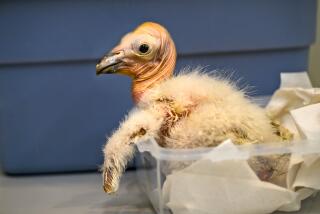Clipboard : Breeding Bird: DOUBLE-CRESTED CORMORANT
- Share via
(Phalacrocorax auritus)
Description: A large, blackish-green water bird, the cormorant has green eyes and a yellow-orange throat and face skin. The bill is slender and hook-tipped. Legs and webbed feet are black. Adults are alike. Breeding adult has a double crest of white tufts curving from behind eyes. Immature birds are brown overall with pale chest, upper breast and neck. Length: 32 inches. Wingspan: 52 inches.
Habitat: Coastal ledges, shore rocks, lakes, rivers.
Diet: Primarily schooling fish.
Displays: Male rapidly pursues female in water, splashing forcefully with both wings; swimming until his head is submerged, he dives, then surfaces holding vegetation that he drops near female or tosses in air.
Nest: Platform of sticks, seaweed and other drift materials on seaward-sloping ledges. Lined with fine grasses. Nests are built either on the ground or in a tree, but never both within the same colony.
Eggs: Light blue or bluish-white. Length: 2 1/3 inches.
Call: Silent except for occasional low grunts in nesting colonies.
Notes: Often stands erect on rocks, neck forming an “S,” with wings spread out to dry. Swims low in water with bill tilted upward; catches fish by “swimming” just below water surface. Eyes are adapted for both aerial and underwater vision.
Breeding bird atlas: To report bird-breeding activity in your neighborhood, or to get information on the breeding bird atlas, call Sea and Sage Audubon Society members Sylvia Gallagher, (714) 962-8990, or Nancy Kenyon, (714) 786-3160.
Note: Map is divided into 5-kilometer squares so that Audubon Society volunteers can more easily survey areas on a regular basis.
Sources: Sea and Sage Audubon Society; “The Birder’s Handbook,” Ehrlich, Dobkin and Wheye, Fireside Books (1988); “Field Guide to the Birds of North America,” National Geographic Society (1987); “Birds of Southern California: Status and Distribution,” Garrett and Dunn, Los Angeles Audubon Society (1981).
Indicates 5-kilometer-square areas where breeding activity has been confirmed.
More to Read
Sign up for Essential California
The most important California stories and recommendations in your inbox every morning.
You may occasionally receive promotional content from the Los Angeles Times.













